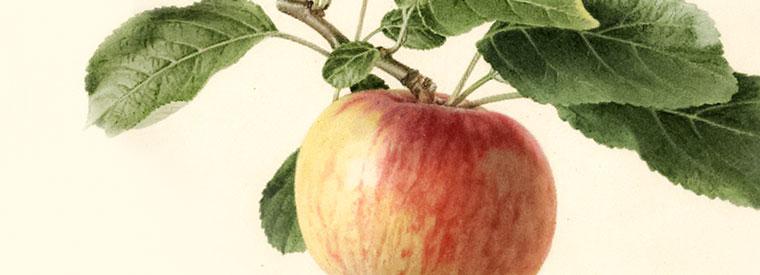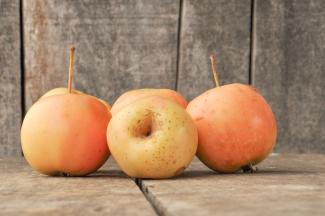Stay me with flagons; comfort me with apples.

Fruit
VIRGINIA (HEWE'S) CRAB is also known as Hewe's Crab, Hugh's Crab and Hughes Crab. There is also a Red Hewes Crab, a seedling of the Virginia Crab, grown by a Colonel Blackburn in Paris, Illinois, before 1869. It is redder in color and larger in size. It was well described by Coxe in A View of Fruit Trees, 1817, as: "The apple is of small size; the form nearly round, the stem long and thin, the skin a dull red mixed with faint streaks of greenish yellow, and numerous small white spots. The flesh is singularly fibrous and astringent: in pressing, it separates from the liquor, which runs through the finest flannel like spring water;…my own practice is to mix the crab pomace in the vat with that of strong rich cider apples, which makes an improved liquor…The tree is of small size, the leaves though small, are of luxuriant growth…the wood hard and tough, never breaking with the load of fruit, usually produced every second year. The origin of this apple is satisfactorily traced to Virginia, where trees nearly one hundred years old, are now standing…" This means that the variety was known in 1717. Coxe continues…"The apple called Hewe's Virginia Crab differs so much from all others that the liquor extracted from it requires a system of management adapted to the peculiar qualities of the fruit." Before the development of hybrid rootstocks, the Virginia Crab was often used as an under stock because of its hardiness, compatibility to many varieties, and vigorous growth. The Virginia Crab was one of the major cider varieties that Thomas Jefferson planted in the north orchard at Monticello. It makes a very high-flavored dry cider, which maintains its quality for a long time and ferments very slowly. In Central Virginia, it ripens in September.
Ripening Period
- Early Fall - September


